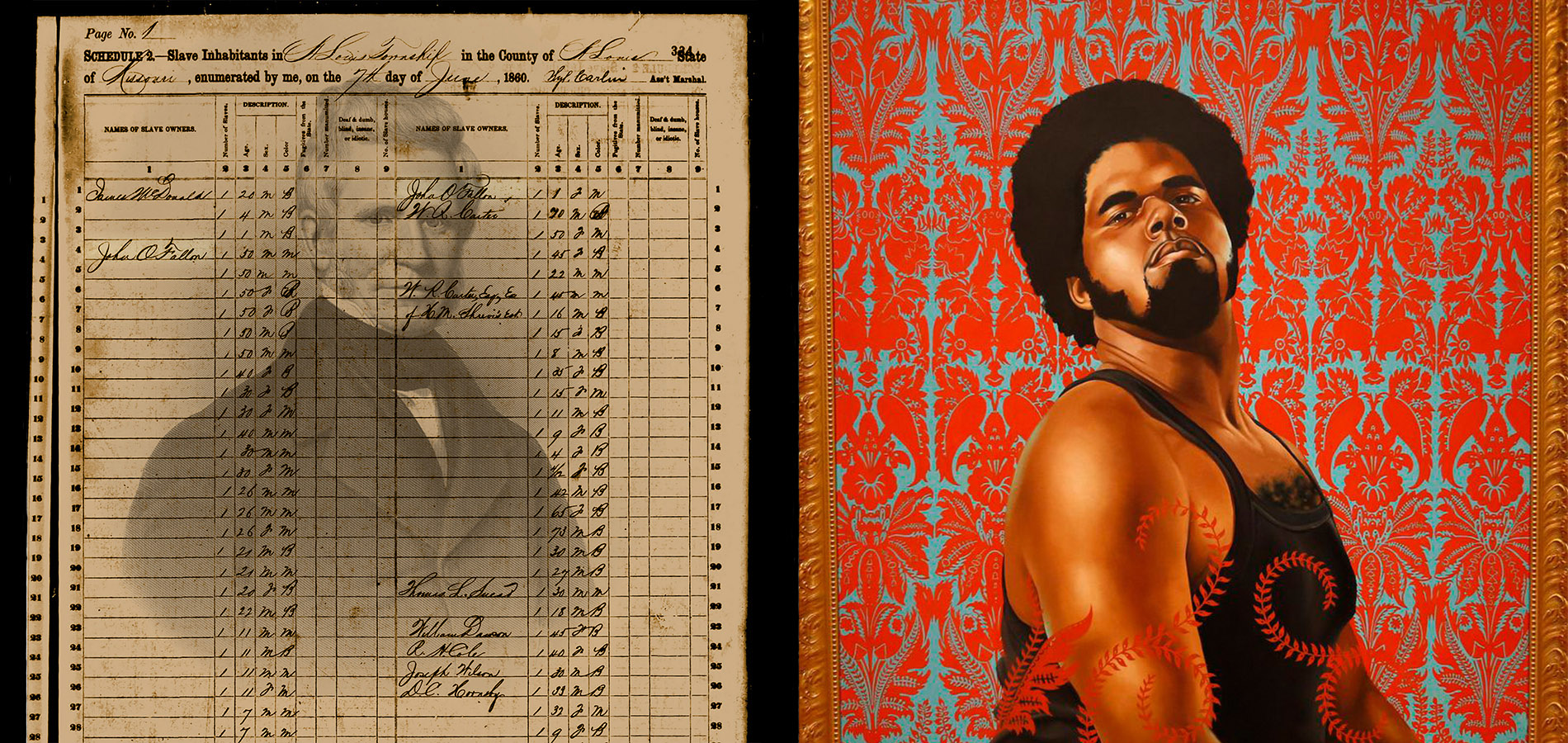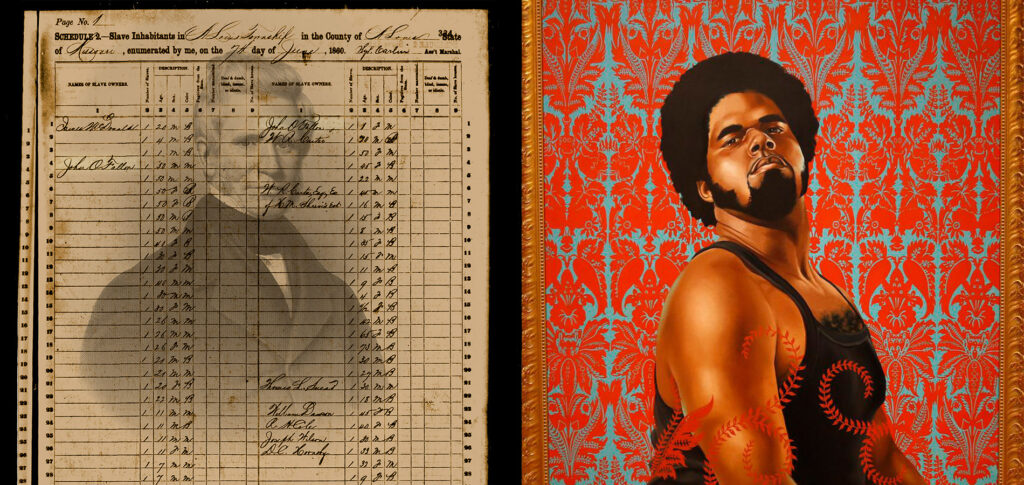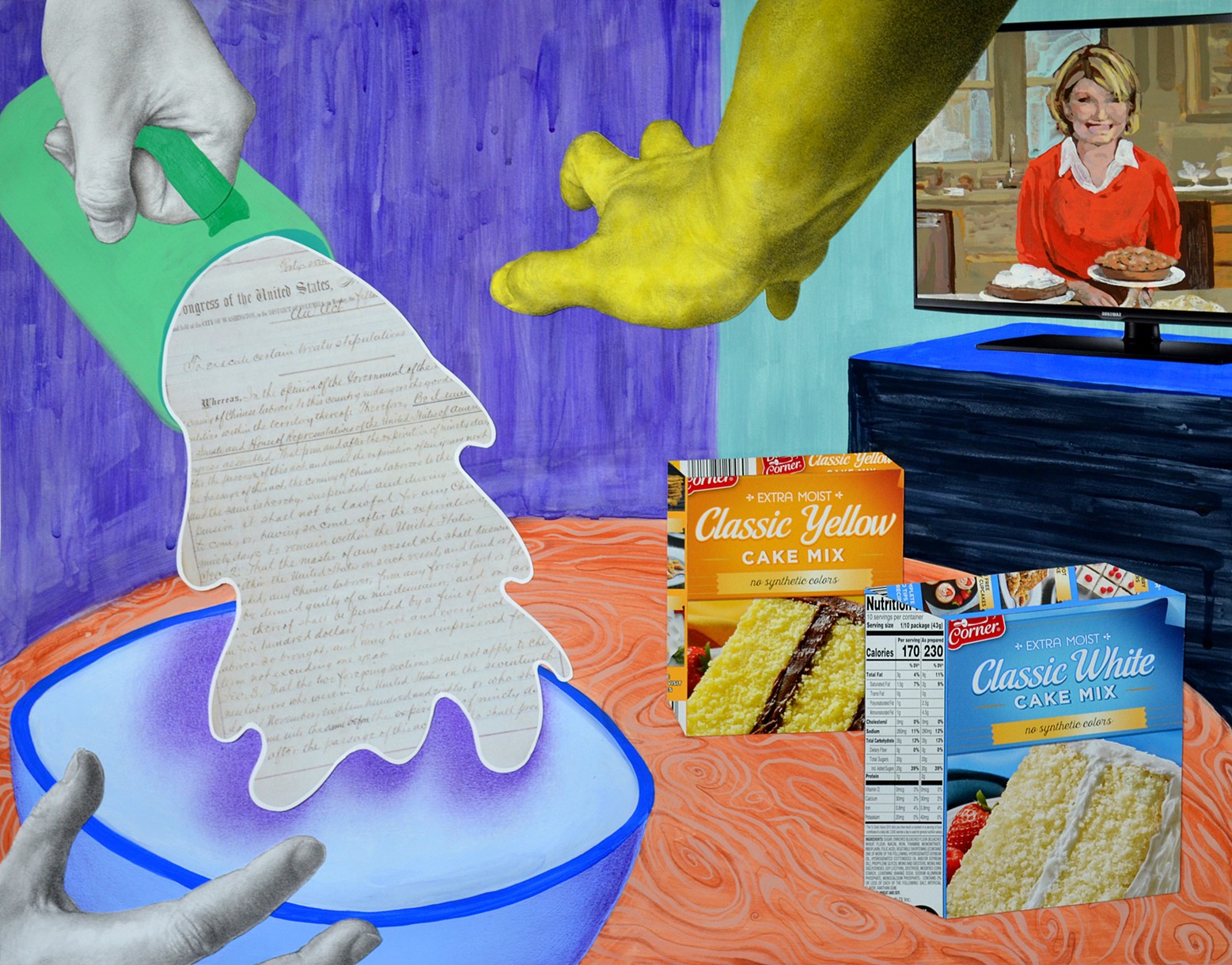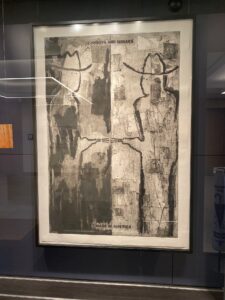
What’s Missing From the Wall? A Spotlight on Race and Representation
The exhibition Counter/Narratives: (Re)presenting Race & Ethnicity juxtaposes and pairs paintings, artifacts, video, and sculptural elements to create a powerful antithesis to representations and omissions still common in museums, libraries, and archives.
The exhibition was organized by Professor of African and African-American Studies Geoff Ward and Exhibitions Manager Jessi Cerutti for the Washington University Libraries.
Counter/Narratives’ ambition and impact come through in the representation of a broad spectrum of artists, ideas, and both iconic and lesser-known works. The exhibition also showcases some of Washington University Libraries’ unique holdings that relate to slavery and the broader African American experience.
The idea of the exhibition took shape when University Libraries were offered the loan of Kehinde Wiley’s painting, The Honorable Augustus Keppel, which forms the centerpiece of the exhibition. Ward, whose research interests include anti-racist and reparative commemorative work, joined forces with Cerutti to curate the exhibition.

Two years ago, Ward curated Truth and Reckonings: The Art of Transformative Racial Justice (2020) at the Mildred Lane Kemper Art Museum, which utilized materials from Washington University Libraries special collections and other artworks to explore the role of memorial museums in promoting critical reflection on history and inspiring reparative change.
“The ability to convey ideas and engage audiences outside typical forms of scholarship and teaching is very interesting and moving for me. When Jessi reached out about this exhibition, I jumped at the offer. Also, as the director of the WashU and Slavery Project, I want to find as many ways as possible for people to encounter the initiative and become involved in it,” said Ward.
A key theme of the exhibition is the subversion of the art of portraiture as a way to counter invisibility and stereotypes and assert identity, pride, and belonging. Wiley’s painting is an ideal representation of this theme. The size and presence of The Honorable Augustus Keppel signify a defiant anti-imperial response to the conventions of European masters.
Among other portraits in Counter/Narratives are late 19th and early 20thcentury photographs of Black St. Louis residents from the George B. Vashon Museum of African American History. At the Vashon Museum, they are a part of a permanent exhibit called the Wall of the Unknown. The posed, formally attired subjects convey dignity, presence, and status.
“These portraits from the Vashon Museum counter the trivialization of Black life and the idea that these people’s lives didn’t matter. The exhibition, as a whole, shows the different ways artists are challenging what we see through portraiture, who we see, and what we take away,” Ward said.
Also included in the category of subversive portraiture are textile and fiber artist Sonya Clark’s rendition of Abraham Lincoln in a series of growing Afros on the five-dollar bill and Washington University MFA student Allena Brazier’s Crown Collection series of elaborate crowns fashioned from Black hair and hairstyling techniques.
The exhibition expands the scope of the university-wide WashU & Slavery Project, which started in 2020, by introducing audiences to historical information and ongoing research on the relationship between Washington University and slavery.
“Conceptually the exhibition is about the way artwork and archival materials can carry narratives but they can also be used to subvert the sort of narratives we are familiar with,” Ward said. “The exhibition helps us build counter-narratives around these figures and around our institutional history.”
One way the exhibition subverts familiar narratives are by graphically altering fine art portraits of founders and chief benefactors of Washington University to illuminate obscured histories of their subjects’ participation in slavery. In an installation on “WashU & Slavery Crime Scenes,” the portraits of John O’ Fallon, Henry Shaw, and Wayman Crow are remade with the visual aesthetics of mugshots by overlaying census records of slave ownership.
While the long-standing narrative about the reputation of Washington University co-founder William Greenleaf Eliot as an abolitionist has been vigorously contested in recent times, the exhibition brings to light the histories of other foundational figures who have avoided scrutiny so far, such as John O’Fallon, one of the largest slave owners in St. Louis and a principal benefactor of the university.
Cerutti explained the mugshots were intended to provide “something visually and graphically rich that captures these complex ideas and was comparable to what contemporary artists like Kehinde Wiley are doing in terms of recontextualizing and reframing historical portraiture techniques.”
The impressive range of work throughout Counter/Narratives truly highlights both racial and aesthetic diversity. The represented styles encompass painting, digital media, sculpture, book arts, and mixed media and filter a variety of racial and cultural perspectives.

Chinese American artist Yikui (Coy) Gu’s canvases show unsettling bicultural experiences through the prism of the Chinese Exclusion Act of 1882. Mexican American painter Enrique Chagoya’s Ghostly Meditations on 19th-century paper reinterprets the history of art via his heritage. St. Louis-based Filipino American artist Janna Añonuevo Langholz uses digital media tools to animate photographs and paintings of her ancestors in Zoom Call with Ancestors.
“The University Libraries are committed to increasing diversity in representations and collaborations across the university and in the community,” Cerutti says. The exhibition began with the impetus of highlighting positive African American representations. “As we started working on the exhibition, Geoff’s idea was to broaden the focus to include other underrepresented voices and communities in art.”
The exhibition brings together work by 15 artists representing a wide range of cultural contexts and identities. “I had been thinking how do we make this as inclusive as we can,” Ward remarked. “In my work as a race scholar, I am trying to push against the Black and white binary that tends to exist in the US context. This commitment to ‘multi-directional memory’ is also a focus of Memory for the Future, the public humanities lab involved in the exhibition.”

Work by several notable artists showcase a wide range of experimental technologies and printmaking techniques that took shape during artist residencies at the famed Island Press of the Sam Fox School of Design and Visual Arts at Washington University.
These include multimedia artist Radcliffe Bailey’s exploration of diasporic African-American history through a rediscovered and modified photograph; artist and Native American activist Jaune Quick-to-See Smith’s collagraph deconstructing the cowboys and Indians trope; and Nuyorican artist and photographer Juan Sanchez’s mixed media prints depicting Latino identity through the joyful image of two young girls.
Rare books and films from the Julian Edison Department of Special Collections are also featured in Counter/Narratives. Kara Walker’s Freedom: A Fable, Sonia Farmer’s A true & exact history, and Washington University Communication Design alumna Evonne Smith’s Botherations of the modern Black woman rewrite and confront stereotypes of Black representation and explore what it means to be a modern Black woman.
“A big part of what we are proud of and interested in advancing is to represent our community as much as possible and this extends to the Libraries Special Collections,” Cerutti said.

The curators have included Steven Carver’s 1969 film More Than One Thing which adds yet another highly engaging dimension to the exhibition. Preserved and digitized by the University Libraries’ Film and Media Archive in 2016, Carver’s film is lauded for breaking with convention by showing a different side of the highly pathologized Pruitt-Igoe housing development and for centering its young, Black protagonist’s consciousness and voice.
“The film can reach people on different levels. These different ways of connecting with objects and ideas have implications for how we understand and remember and what we feel,” Ward said.
The final pieces of the exhibition evince striking levels of originality and complexity through the ways they challenge, reframe, and imagine the themes of race and healing.
Multi-media artist Roberto Visani’s cardboard slave kit, a do-it-yourself sculpture, transforms the supplicant slave trope in 19th-century abolitionist European art. Chosen for “its argument with art history and the white savior narrative,” as Cerutti puts it, Visani’s slave kit invites participants to assemble a “slave sculpture” to better understand interweaving discourses of commerce, modernization, enslavement, abolition, and freedom.
Similarly, Sonya Clark’s installation looks into Black history and experience in the United States and invites viewers to engage with the Confederate Truce Flag that marked the end of the Civil War in 1865 as a symbol of peace and reparation.
Students in Ward’s spring 2022 class on Legacies of Racial Violence will visit Olin Library to help assemble Visani’s sculpture. Ward hopes it will lead to a conversation about the artist’s vision and how it works.
“I am attracted to Visani and Clark’s works because of the labor they require. It is not a passive consumption of art and archival materials. They are requiring you to get your hands in it. It has an affective impact,” Ward noted.
Counter/Narratives is on display until July 18, 2022, in the Thomas Gallery at John M. Olin Library.
